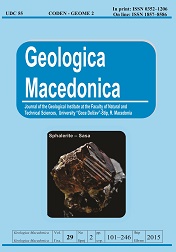Mineralogical and geochemical characterization of silica-carbonate gemstone veins from Gaj-Lazine (central Serbia)
Abstract
Gemstone deposit Gaj-Lazine is located in central Serbia, 70 km south from Belgrade. Buff brown and red jaspers and colourless chalcedony are the main gemstone types, with subdued magnesite and quartz. Complex veins consisting of these minerals are filling up the fractures and vugs within the host serpentinite rock. The host rock is intensely altered – listwenitized, due to the circulation of hydrothermal solutions from which the gemstone veins have formed via sol phase. As geological features of the gemstone deposit Gaj-Lazine with its economic significance have been previously published in detail, further laboratory examinations' results are shown here. Microscopic analysis has shown that magnesite and jasper have formed contemporaneously. X-ray powder diffraction analyses have shown that the red jasper consists of quartz (crypto- to microcrystalline silica) with minor hematite, while the altered serpentinite host rock consists of quartz, dolomite, smectite clay and serpentine minerals. The results of atomic absorption spectrophotometric analysis have indicated the presence of the elements originating from the ophiolite sequence, Cretaceous limestones and clay minerals.

